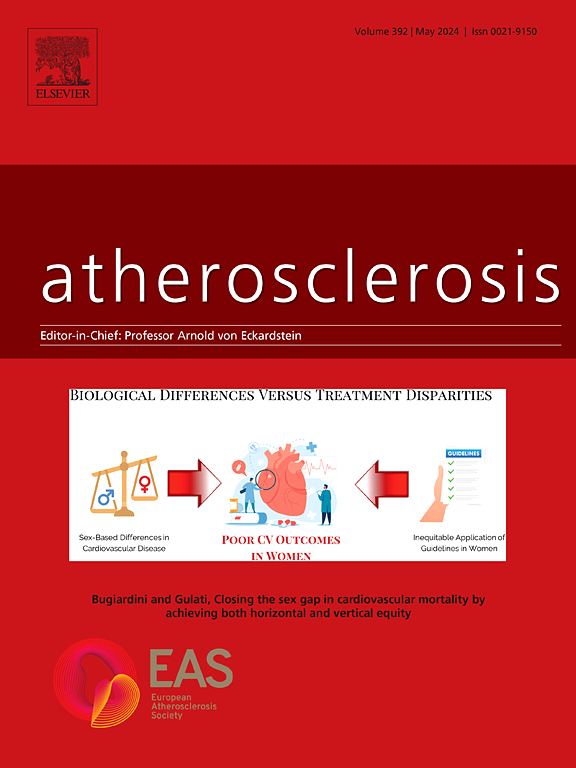Impact of the clinical diagnostic strata of familial hypercholesterolemia on risk stratification among patients with hypercholesterolemia
IF 4.9
2区 医学
Q1 CARDIAC & CARDIOVASCULAR SYSTEMS
引用次数: 0
Abstract
Background and aims
In 2022, the Japan Atherosclerosis Society (JAS) revised clinical diagnostic criteria of familial hypercholesterolemia (FH), adopting the use of definite, probable, possible, and unlikely FH categories following the Dutch Lipid Clinic Network (DLCN) FH criteria. However, whether these strata would be useful for the risk stratification of coronary artery disease (CAD) events among patients with hypercholesterolemia is unclear.
Methods
We retrospectively reviewed the data of patients with hypercholesterolemia (LDL cholesterol ≥180 mg/dL) aged ≥15 years (N = 1,273, male = 631) admitted to Kanazawa University Hospital between 2000 and 2022. Using the Cox proportional hazard model, we assessed whether factors, including the diagnostic strata of FH, were associated with CAD events.
Results
We identified 572, 174, 196, and 331 patients with definite, probable, possible, and unlikely FH, respectively. The prevalence of the pathogenic variant of FH was 71.0 %, 25.9 %, 11.7 %, and 1.5 %, respectively, among patients with definite, probable, possible, and unlikely FH (p < 0.001). We identified 144 CAD events during the 12.4 year median follow-up. Compared with the reference group of unlikely FH, subjects with definite, probable, and possible FH had significantly higher hazard ratios (HRs) of developing CAD events (HR, 6.44; 95 % confidence interval [CI], 2.64–10.24; p < 0.001 and HR, 3.10; 95 % CI, 1.51–4.51; p < 0.001, and HR, 1.88; 95 % CI, 1.08–2.60; p = 0.02, respectively).
Conclusion
Among patients with hypercholesterolemia, the JAS clinical diagnostic strata of FH are useful for risk discrimination beyond their diagnosis as FH.

家族性高胆固醇血症临床诊断分层对高胆固醇血症患者危险分层的影响
背景和目的在2022年,日本动脉粥样硬化协会(JAS)修订了家族性高胆固醇血症(FH)的临床诊断标准,采用了确定的、可能的、可能的和不可能的FH分类,遵循荷兰脂质临床网络(DLCN) FH标准。然而,这些分层是否对高胆固醇血症患者冠状动脉疾病(CAD)事件的风险分层有用尚不清楚。方法回顾性分析2000 ~ 2022年金泽大学医院收治的年龄≥15岁的高胆固醇血症(LDL胆固醇≥180 mg/dL)患者(N = 1,273例,男性= 631例)的资料。使用Cox比例风险模型,我们评估了包括FH诊断层在内的因素是否与CAD事件相关。结果我们分别鉴定出572例、174例、196例和331例确诊、可能、可能和不太可能的FH患者。在确诊、可能、可能和不太可能感染FH的患者中,FH致病性变异的患病率分别为71.0%、25.9%、11.7%和1.5% (p <;0.001)。在12.4年的中位随访期间,我们确定了144例CAD事件。与不可能发生FH的参照组相比,确定、可能和可能发生FH的受试者发生CAD事件的危险比(HR, 6.44;95%置信区间[CI], 2.64-10.24;p & lt;0.001, HR为3.10;95% ci, 1.51-4.51;p & lt;0.001, HR为1.88;95% ci, 1.08-2.60;P = 0.02)。结论在高胆固醇血症患者中,FH的JAS临床诊断层可用于诊断为FH以外的风险鉴别。
本文章由计算机程序翻译,如有差异,请以英文原文为准。
求助全文
约1分钟内获得全文
求助全文
来源期刊

Atherosclerosis
医学-外周血管病
CiteScore
9.80
自引率
3.80%
发文量
1269
审稿时长
36 days
期刊介绍:
Atherosclerosis has an open access mirror journal Atherosclerosis: X, sharing the same aims and scope, editorial team, submission system and rigorous peer review.
Atherosclerosis brings together, from all sources, papers concerned with investigation on atherosclerosis, its risk factors and clinical manifestations. Atherosclerosis covers basic and translational, clinical and population research approaches to arterial and vascular biology and disease, as well as their risk factors including: disturbances of lipid and lipoprotein metabolism, diabetes and hypertension, thrombosis, and inflammation. The Editors are interested in original or review papers dealing with the pathogenesis, environmental, genetic and epigenetic basis, diagnosis or treatment of atherosclerosis and related diseases as well as their risk factors.
 求助内容:
求助内容: 应助结果提醒方式:
应助结果提醒方式:


